当前位置:
X-MOL 学术
›
Journal of Theoretical and Applied Mechanics
›
论文详情
Our official English website, www.x-mol.net, welcomes your
feedback! (Note: you will need to create a separate account there.)
A study on the failure behavior of Al2O3-Ni micro-layered beams under three point bending
Theoretical and Applied Fracture Mechanics ( IF 5.0 ) Pub Date : 2020-12-01 , DOI: 10.1016/j.tafmec.2020.102773 Mengwen Zhang , Xudong Sun , Xiaozhi Hu
Theoretical and Applied Fracture Mechanics ( IF 5.0 ) Pub Date : 2020-12-01 , DOI: 10.1016/j.tafmec.2020.102773 Mengwen Zhang , Xudong Sun , Xiaozhi Hu

|
Abstract Ceramic-metal laminated composites consisting of alternating ceramic and metal micro-layers can create unique “structural or composite properties” superior to the material properties of individual constituent ceramics and metals. Those unique “composite or structural properties” cannot be adequately modeled by Linear Elastic Fracture Mechanics (LEFM) or Strength of Materials (SoM) since both models are limited to homogeneous materials. A recent composite fracture model with an approximate empirical solution is adopted in this study to determine both the “structural or composite” tensile strength and fracture toughness of micro-layered Al2O3-Ni laminar composites, which were prepared through gel-casting and hot-pressing. This simple empirical model considers the micro-cracking or damage zone in the highly stressed region, e.g. at notch tip, and the most prominent composite microstructure, i.e. the thickness Cch of ductile Ni micro-layers. A linear relation between the maximum fracture loads Pmax and the equivalent area Ae was confirmed with the “structural or composite” tensile strength ft as the slope. The “structural or composite” fracture toughness KIC was then determined by ft and Cch. This simple empirical model can also be used together with normal distribution so that both the mean and 95% reliability band can be predicted. The “structural or composite” properties determined by the simple composite fracture model were compared with rough approximations from LEFM and SoM (both should not be used for composites) so that readers can see the errors if those classic models suitable only to homogeneous materials are used.
中文翻译:

Al2O3-Ni微层状梁三点弯曲破坏行为研究
摘要 由交替的陶瓷和金属微层组成的陶瓷-金属层压复合材料可以创造独特的“结构或复合性能”,优于单独组成陶瓷和金属的材料性能。线性弹性断裂力学 (LEFM) 或材料强度 (SoM) 无法对这些独特的“复合或结构特性”进行充分建模,因为这两种模型都仅限于均质材料。本研究采用具有近似经验解的最新复合材料断裂模型来确定通过凝胶浇注和热压制备的微层状 Al2O3-Ni 层状复合材料的“结构或复合”拉伸强度和断裂韧性. 这个简单的经验模型考虑了高应力区域中的微裂纹或损坏区域,例如在缺口尖端,和最突出的复合微观结构,即韧性镍微层的厚度Cch。以“结构或复合材料”抗拉强度 ft 作为斜率,确认了最大断裂载荷 Pmax 与等效面积 Ae 之间的线性关系。然后通过 ft 和 Cch 确定“结构或复合”断裂韧性 KIC。这个简单的经验模型也可以与正态分布一起使用,以便预测均值和 95% 的可靠性带。由简单复合材料断裂模型确定的“结构或复合材料”属性与 LEFM 和 SoM 的粗略近似值(两者均不应用于复合材料)进行比较,以便读者可以在使用仅适用于均质材料的经典模型时看到错误. 延展性 Ni 微层的厚度 Cch。以“结构或复合材料”抗拉强度 ft 作为斜率,确认了最大断裂载荷 Pmax 与等效面积 Ae 之间的线性关系。然后通过 ft 和 Cch 确定“结构或复合”断裂韧性 KIC。这个简单的经验模型也可以与正态分布一起使用,以便预测均值和 95% 的可靠性带。由简单复合材料断裂模型确定的“结构或复合材料”属性与 LEFM 和 SoM 的粗略近似值(两者均不应用于复合材料)进行比较,以便读者可以在使用仅适用于均质材料的经典模型时看到错误. 延展性 Ni 微层的厚度 Cch。以“结构或复合材料”抗拉强度 ft 作为斜率,确认了最大断裂载荷 Pmax 与等效面积 Ae 之间的线性关系。然后通过 ft 和 Cch 确定“结构或复合”断裂韧性 KIC。这个简单的经验模型也可以与正态分布一起使用,以便可以预测均值和 95% 的可靠性带。由简单复合材料断裂模型确定的“结构或复合材料”属性与 LEFM 和 SoM 的粗略近似值(两者均不应用于复合材料)进行比较,以便读者可以在使用仅适用于均质材料的经典模型时看到错误. 以“结构或复合材料”抗拉强度 ft 作为斜率,确认了最大断裂载荷 Pmax 与等效面积 Ae 之间的线性关系。然后通过 ft 和 Cch 确定“结构或复合”断裂韧性 KIC。这个简单的经验模型也可以与正态分布一起使用,以便预测均值和 95% 的可靠性带。由简单复合材料断裂模型确定的“结构或复合材料”属性与 LEFM 和 SoM 的粗略近似值(两者均不应用于复合材料)进行比较,以便读者可以在使用仅适用于均质材料的经典模型时看到错误. 以“结构或复合材料”抗拉强度 ft 作为斜率,确认了最大断裂载荷 Pmax 与等效面积 Ae 之间的线性关系。然后通过 ft 和 Cch 确定“结构或复合”断裂韧性 KIC。这个简单的经验模型也可以与正态分布一起使用,以便预测均值和 95% 的可靠性带。将由简单复合材料断裂模型确定的“结构或复合材料”属性与 LEFM 和 SoM 的粗略近似值进行比较(两者均不应用于复合材料),以便读者可以在使用仅适用于均质材料的经典模型时看到错误. 然后通过 ft 和 Cch 确定“结构或复合”断裂韧性 KIC。这个简单的经验模型也可以与正态分布一起使用,以便预测均值和 95% 的可靠性带。由简单复合材料断裂模型确定的“结构或复合材料”属性与 LEFM 和 SoM 的粗略近似值(两者均不应用于复合材料)进行比较,以便读者可以在使用仅适用于均质材料的经典模型时看到错误. 然后通过 ft 和 Cch 确定“结构或复合”断裂韧性 KIC。这个简单的经验模型也可以与正态分布一起使用,以便预测均值和 95% 的可靠性带。由简单复合材料断裂模型确定的“结构或复合材料”属性与 LEFM 和 SoM 的粗略近似值(两者均不应用于复合材料)进行比较,以便读者可以在使用仅适用于均质材料的经典模型时看到错误.
更新日期:2020-12-01
中文翻译:

Al2O3-Ni微层状梁三点弯曲破坏行为研究
摘要 由交替的陶瓷和金属微层组成的陶瓷-金属层压复合材料可以创造独特的“结构或复合性能”,优于单独组成陶瓷和金属的材料性能。线性弹性断裂力学 (LEFM) 或材料强度 (SoM) 无法对这些独特的“复合或结构特性”进行充分建模,因为这两种模型都仅限于均质材料。本研究采用具有近似经验解的最新复合材料断裂模型来确定通过凝胶浇注和热压制备的微层状 Al2O3-Ni 层状复合材料的“结构或复合”拉伸强度和断裂韧性. 这个简单的经验模型考虑了高应力区域中的微裂纹或损坏区域,例如在缺口尖端,和最突出的复合微观结构,即韧性镍微层的厚度Cch。以“结构或复合材料”抗拉强度 ft 作为斜率,确认了最大断裂载荷 Pmax 与等效面积 Ae 之间的线性关系。然后通过 ft 和 Cch 确定“结构或复合”断裂韧性 KIC。这个简单的经验模型也可以与正态分布一起使用,以便预测均值和 95% 的可靠性带。由简单复合材料断裂模型确定的“结构或复合材料”属性与 LEFM 和 SoM 的粗略近似值(两者均不应用于复合材料)进行比较,以便读者可以在使用仅适用于均质材料的经典模型时看到错误. 延展性 Ni 微层的厚度 Cch。以“结构或复合材料”抗拉强度 ft 作为斜率,确认了最大断裂载荷 Pmax 与等效面积 Ae 之间的线性关系。然后通过 ft 和 Cch 确定“结构或复合”断裂韧性 KIC。这个简单的经验模型也可以与正态分布一起使用,以便预测均值和 95% 的可靠性带。由简单复合材料断裂模型确定的“结构或复合材料”属性与 LEFM 和 SoM 的粗略近似值(两者均不应用于复合材料)进行比较,以便读者可以在使用仅适用于均质材料的经典模型时看到错误. 延展性 Ni 微层的厚度 Cch。以“结构或复合材料”抗拉强度 ft 作为斜率,确认了最大断裂载荷 Pmax 与等效面积 Ae 之间的线性关系。然后通过 ft 和 Cch 确定“结构或复合”断裂韧性 KIC。这个简单的经验模型也可以与正态分布一起使用,以便可以预测均值和 95% 的可靠性带。由简单复合材料断裂模型确定的“结构或复合材料”属性与 LEFM 和 SoM 的粗略近似值(两者均不应用于复合材料)进行比较,以便读者可以在使用仅适用于均质材料的经典模型时看到错误. 以“结构或复合材料”抗拉强度 ft 作为斜率,确认了最大断裂载荷 Pmax 与等效面积 Ae 之间的线性关系。然后通过 ft 和 Cch 确定“结构或复合”断裂韧性 KIC。这个简单的经验模型也可以与正态分布一起使用,以便预测均值和 95% 的可靠性带。由简单复合材料断裂模型确定的“结构或复合材料”属性与 LEFM 和 SoM 的粗略近似值(两者均不应用于复合材料)进行比较,以便读者可以在使用仅适用于均质材料的经典模型时看到错误. 以“结构或复合材料”抗拉强度 ft 作为斜率,确认了最大断裂载荷 Pmax 与等效面积 Ae 之间的线性关系。然后通过 ft 和 Cch 确定“结构或复合”断裂韧性 KIC。这个简单的经验模型也可以与正态分布一起使用,以便预测均值和 95% 的可靠性带。将由简单复合材料断裂模型确定的“结构或复合材料”属性与 LEFM 和 SoM 的粗略近似值进行比较(两者均不应用于复合材料),以便读者可以在使用仅适用于均质材料的经典模型时看到错误. 然后通过 ft 和 Cch 确定“结构或复合”断裂韧性 KIC。这个简单的经验模型也可以与正态分布一起使用,以便预测均值和 95% 的可靠性带。由简单复合材料断裂模型确定的“结构或复合材料”属性与 LEFM 和 SoM 的粗略近似值(两者均不应用于复合材料)进行比较,以便读者可以在使用仅适用于均质材料的经典模型时看到错误. 然后通过 ft 和 Cch 确定“结构或复合”断裂韧性 KIC。这个简单的经验模型也可以与正态分布一起使用,以便预测均值和 95% 的可靠性带。由简单复合材料断裂模型确定的“结构或复合材料”属性与 LEFM 和 SoM 的粗略近似值(两者均不应用于复合材料)进行比较,以便读者可以在使用仅适用于均质材料的经典模型时看到错误.









































 京公网安备 11010802027423号
京公网安备 11010802027423号